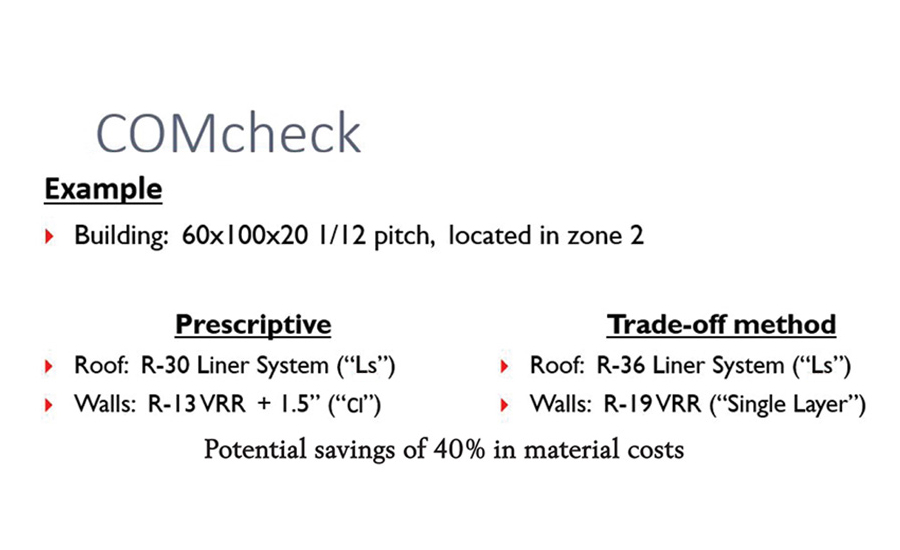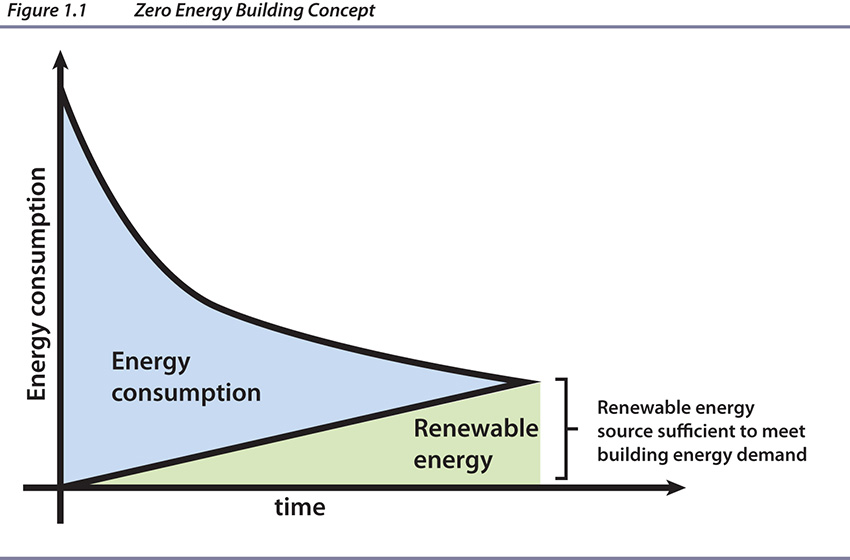Envelope-Based Solutions for Metal Buildings
COMcheck for Performance Compliance
Many designers use COMcheck, a free software developed by the U.S. Department of Energy, as an optimization tool and to prove code compliance. The use of COMcheck falls under the performance compliance method because it provides values for the building’s overall performance and replaces the individual prescriptive requirements for building envelopes and assemblies.
However, there are states and jurisdictions that do not allow the use of COMcheck as proof of compliance, so a designer must confirm what is allowed by that jurisdiction. The U.S. Department of Energy website includes a map showing which states allow use of the software, but it is always best to check with a local code official.
COMcheck allows the use of trade-offs and value engineering in the building envelope. For example, a user may choose to specify a roof assembly with a U-factor below what is required by code combined with a wall assembly with lower R-values. COMcheck can produce a report that shows your building meets code to submit to your local code official.
Using COMcheck not only proves compliance, it can also potentially save time and materials with alternatives to the prescriptive path. For example, consider a 60 by 100 by 20-foot metal building located in Climate Zone 2. The prescriptive path requires the following roof and wall insulation:
Roof: R-19 + R-11 Liner System
Walls: R-13 + R-6.5 (ci)
Using the performance-based method by increasing the roof system to an R-36 liner system and simplifying the wall system to a single layer of R-19 fiberglass insulation would result in a material cost savings of 40 percent (at current average insulation prices) with no sacrifice in performance. This example illustrates the concept of value engineering which seeks the best performing solution at the lowest cost. In this way, COMcheck can be used both as a compliance and optimization tool.
ci and Thermal Spacers
One of the more challenging requirements found in the prescriptive tables of ASHRAE 90.1 and the IECC is the use of ci. The use of rigid board insulation as ci in the field can be expensive and labor-intensive to install—though it may be a good choice for retrofits. The placement of ci in wall assemblies can require longer panel attachment screws, modified trims at base and framed opening conditions, and possibly longer roof panels to extend past the entire wall assembly. The use of U-factor compliance allows for alternative assemblies that do not include ci. Insulated Metal Panels (IMP) can also be a viable solution to satisfy a ci requirement while minimizing the number of components in a wall assembly.
The prescriptive tables may also require R-5 thermal spacers in standing seam roof assemblies. This is because the tables are based off of computer modeling and hot box testing of assemblies that happened to have R-5 thermal spacers. However, the “U-factor method” (for both ASHRAE 90.1 and IECC) does not specify thermal spacer size or purlin space requirements; meaning that code compliance can be achieved without a thermal spacer at all.

Since U-factor compliance can be a more complicated approach, it tends to be avoided. It requires hotbox testing or computer modeling to determine the U-factor of the roof assembly, taking into account the actual R-value of the thermal spacer as well as purlin spacing and the clip stand-off dimension. Fortunately, Owens Corning in conjunction with ASHRAE published a paper in 2010 that offers a calculation method based on modeling and testing of a generic system that will take into account any R-value thermal spacer and purlin space. This information, when put into COMcheck or other energy code compliance check software, can be used to show compliance without the use of R-5 thermal spacers.
Looking Ahead: Envelope- Based Solutions
No matter which code a state or jurisdiction follows, future codes will become even more stringent. ASHRAE 90.1-2013/IECC 2015 represents a 15 percent improvement over previous versions. In addition to increased insulation values, the newer code includes improvements in air infiltration, increased HVAC efficiency and daylighting. These improvements represent one of many steps to the ultimate goal: net-zero energy buildings, combining reduced demand with renewable energy systems. By the time we see ASHRAE 90.1-2025/IECC 2027, that goal will no longer be a distant reality; it will be the norm. The best thing you can do now is to anticipate these changes and prepare for them.
Several trends, including more demanding energy codes, green building rating systems such as LEED, and legislative requirements such as California’s net-zero energy building mandate, are driving increased performance of the building envelope. At the same time, many customers have a lack of experience with the new requirements and a dearth of technical resources. The competitive nature of the construction industry makes it hard for builders to take the time to get up to speed. For projects without a single A/E and CM firm overseeing both design and construction, the increased performance requirements make projects more expensive and difficult to design. They also create a “proof of compliance” vacuum that can result in increased difficulty getting permits and certificates of occupancy across the nation.
Customers need help resolving these issues, and manufacturers can be supportive partners. Many provide envelope-based solutions that help meet stringent newer code requirements. In addition, some provide custom solutions based on COMcheck and provide support throughout the process. We are seeing increased collaboration between manufacturers (those who provide metal building components and insulation manufacturers, for example), enabling them to provide holistic solutions that meet several project goals at once.

ASHRAE 90.1-2013/IECC 2015 sets goals as a 15 percent improvement over current 2010/2012 code with full insulation, air infiltration improvements, daylighting required and increased HVAC efficiency. ASHRAE 90.1-2025 IECC 2027 set net-zero as the goal, with alternative energy sources and supporting green energy.
Meeting Energy Code Requirements
Many building manufacturers offer insulation systems as part of their building package to minimize conflicts with the building design. Let’s take a look at some of these options.
Insulation is a cost-effective solution, easy to obtain and install. Systems are specifically designed for use with metal buildings, which allow for absorption of a small amount of condensation. These solutions also provide a clean and finished look to the building interior. Here are some typical higher performance insulation solutions for metal building roofs and walls:
Filled Cavity or “Long Tab” Systems: consisting of two layers of insulation, the bottom faced layer runs parallel to the purlins within the cavity and is supported by steel banding fastened to the bottom of the purlins. This layer has extra wide tabs (typically 15 inches) that wrap around and cover the tops of the purlins. The second layer is unfaced and runs parallel or perpendicular to the purlins.
Liner Systems: these consist of two layers of insulation, both unfaced. The bottom unfaced layer runs parallel to the purlins, while the top unfaced layer runs perpendicular over the purlins. Steel banding is fastened to the bottom of the purlins to support a continuous fabric liner that acts as the vapor barrier. The steel banding and fabric together support the unfaced layer of insulation on the bottom. This system also can be used for wall applications.
Filled cavity and liner systems have the potential for improved thermal performance since compression of insulation is minimized. However, proper design and installation of these systems is critical to achieve rated performance.
“Sag and Bag” or Double Layer Systems: these involve a layer of faced fiberglass insulation draped across and sagging between the purlins. This layer is followed by a second layer of unfaced fiberglass insulation installed above and between the purlins.
Insulated Metal Panels
Designed for use in both wall and roof applications, IMPs are comprised of highly energy efficient, factory-controlled foam insulation sandwiched between a finished metal exterior and an interior face. At R-7+ per-inch, the insulating value of the closed cell polyisocyanurate core provides exceptional thermal performance, and the panels allow for fast, efficient construction. These products offer nearly three times the insulation efficiency as a field-assembled fiberglass system. An IMP that is around 3 inches can achieve R-20, whereas a wall system utilizing fiberglass with a separate liner would need to be approximately 7.5 inches thick.
IMPs are generally more expensive compared to fiberglass, but they can save labor costs with a single installation. This solution also leaves purlin and girt cavities free for other trades (e.g. electrical and plumbing). IMPs work well with standard metal building girt and purlin spacing. There are also solutions available for cold storage and applications requiring fire-rated assemblies.
Both IMPs and fiberglass insulation are ideal solutions to meet code depending on project requirements and specifications. Both products typically can be installed by the crews who erect the building. Manufacturers test their assemblies to ASTM C1363 and are able to provide tables with calculated U-factors for some typical wall and roof assemblies using their products and systems.









